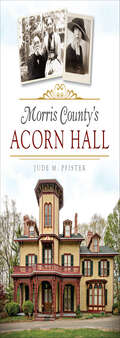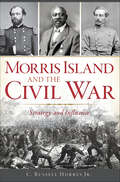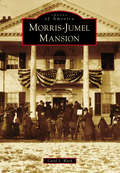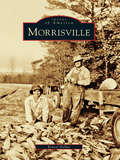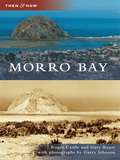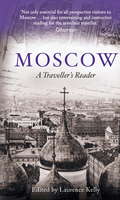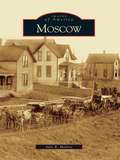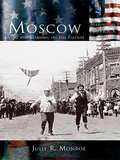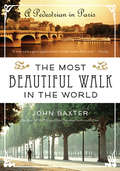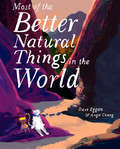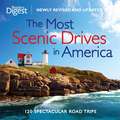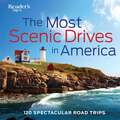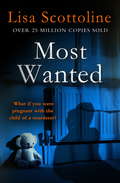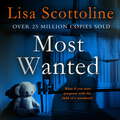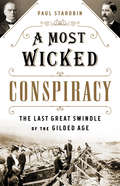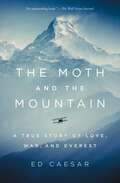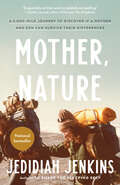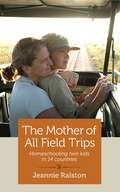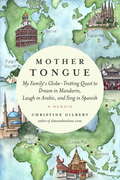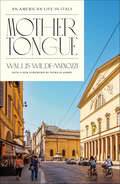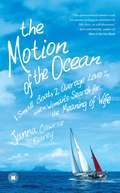- Table View
- List View
Morris County's Acorn Hall (Landmarks)
by Jude M. PfisterAcorn Hall has always been a home. In 1852, Dr. John Schermerhorn conceived the sprawling estate and mansion, and he spent four years decorating it in a lavish Rococo style. Banker Augustus Crane later bought the estate and mansion, had it redesigned and rechristened it Acorn Hall, and it remained in his family through two world wars and numerous financial crises. Mary Crane Hone donated the landmark to the Morris County Historical Society in 1971. After its devoted members lovingly restored the hall, it became a focal point for the community and a beautiful setting for the society's collections. Today, it is imbued with a sense of purpose, tradition and reverence for the past. Local historian Jude Pfister tells the remarkable story of Morris County, New Jersey's Acorn Hall.
Morris Island and the Civil War: Strategy and Influence (Civil War Series)
by C. Russell Horres Jr.From Charleston's doorstep, Morris Island held a critical position in the Civil War. It was first used by Confederates to assist in the bombardment of Fort Sumter and later became the scene of an epic struggle to prevent Union forces from gaining control. After the battle, the roles reversed, and Union forces used the site to bombard Fort Sumter and Charleston. Hundreds lost their lives, and both sides expended a vast amount of war capital for what appeared to be little value. Confederates greatly underestimated how events at Morris Island played into the hands of the Civil War's master strategist, Abraham Lincoln. Author C. Russell Horres Jr. offers the complete story of Morris Island in the War Between the States.
Morris-Jumel Mansion
by Carol S. WardMorris-Jumel Mansion is an engaging look at the history of Manhattan's oldest residence. Built by Roger Morris in 1765 as a summer estate, it has truly been a witness to history throughout the last 250 years. Located in the upper Manhattan neighborhood of Washington Heights, the mansion sits on a large hill, with sweeping views of both the East and Hudson Rivers. George Washington strategically located his headquarters here during the fall of 1776, but the Jumels, who made the house their home from 1810 to 1895, left the most indelible mark. In 1904, the residence became a museum, thanks to the Daughters of the American Revolution, who saved the house and allowed it to grow with the changing neighborhood. Today, this landmark is a symbol of both the long history of the city and the contemporary face of its now diverse neighborhood.
Morrisville
by Ernest DollarMorrisville is known as a small, sleepy town in central North Carolina. However, this town in the heart of the state's most technological area has a long and colorful past. The Morrisville community traces its origin to its location on the state's colonial east-west road and became a town, naming itself after resident Jeremiah Morris, with the arrival of the North Carolina Railroad in 1852. Its strategic stop along the railroad brought warring armies during the Civil War, and afterward, residents hoped the railroad would make Morrisville a prosperous town of the New South. Progress came slowly, and Morrisville became a farming community frozen in time for the next 100 years. With the rapid growth of the Research Triangle in the 1980s, Morrisville found itself enveloped by a quickly changing community. Located by the state's largest airport and a major interstate, Morrisville became the new center for several technologically advanced research facilities and home to many new families enjoying the town's rural charm.
Morro Bay
by Garry Johnson Gary Ream Roger CastleMorro Bay began as a coastal fishing and farming village. Today it is a well-known vacation destination. At its heart, it has changed little since John Riley first envisioned it in 1872. The community has had brushes with dramatic change, but fate has allowed it to remain a typical American small town. Author Roger Castle was born and raised in Morro Bay. Coauthor Gary Ream and photographer Garry Johnson are relative newcomers. Through their eyes, here is a view of a modern, but ageless Morro Bay.
Moscow: A Traveller's Reader
by Laurence KellyFounded in 1147, Moscow was for much of its early history in thrall to other nations - to the Khans, the Tartars and the Poles. The city was devastated by fire time and again, but with each rebuilding, it grew ever more magnificent. For every church that was destroyed, it seemed that two more were built. In this evocative and fascinating anthology, Moscow's turbulent growth is recorded through the voices of visitors and residents: Peter the Great's bloody reprisals after the revolt of the streltsy in 1698; a visit to the city's brothels by medical students in the 1890s; Kutuzov abandoning Moscow to Napoleon in 1812, and Napoleon's ignominious retreat from the burning city; Pushkin railing against the mindlessness of 1830 society; the flowering of literary greatness in the ninenteenth century and of the Moscow Art Theatre in the twentieth; and the dazzling profusion of jewels in the Treasury of the Kremlin.These and many other milestones in over seven hundred years of history are brought vividly to life.
Moscow: A Traveller's Reader
by Laurence KellyFounded in 1147, Moscow was for much of its early history in thrall to other nations - to the Khans, the Tartars and the Poles. The city was devastated by fire time and again, but with each rebuilding, it grew ever more magnificent. For every church that was destroyed, it seemed that two more were built. In this evocative and fascinating anthology, Moscow's turbulent growth is recorded through the voices of visitors and residents: Peter the Great's bloody reprisals after the revolt of the streltsy in 1698; a visit to the city's brothels by medical students in the 1890s; Kutuzov abandoning Moscow to Napoleon in 1812, and Napoleon's ignominious retreat from the burning city; Pushkin railing against the mindlessness of 1830 society; the flowering of literary greatness in the ninenteenth century and of the Moscow Art Theatre in the twentieth; and the dazzling profusion of jewels in the Treasury of the Kremlin.These and many other milestones in over seven hundred years of history are brought vividly to life.
Moscow
by Julie R. MonroeEach spring for centuries, the Nez Perce Indians visited the area they called Taxt-hinma (place of the spotted deer) to harvest the camas root. Today Taxt-hinma is Moscow, Idaho, a forward-looking university community dedicated to preserving the spirit of place that attracted the area's first permanent settlers in 1871. Originally known as Paradise, Moscow started out as a trading center serving homesteaders settling the prodigiously fertile Palouse. Since its incorporation as a city in 1887, Moscow has grown steadily upon a foundation of education and agriculture. From its central core of notable commercial and public buildings to the splendid houses that once sheltered its founders to the scenic University of Idaho campus, Moscow is clearly a community that values its cultural, economic, architectural, and natural heritage.
Moscow: Living and Learning on the Palouse (Making of America)
by Julie R. MonroeCentered in the glorious Palouse, a richly fertile area, the small Idaho town of Moscow was once home to the Nez Perce, who introduced the famous spotted Appaloosa horses. The intimate Moscow feel inspired by current residents has persisted since the original homesteaders settled here, a place they called "Paradise Valley." Resisting the anonymity of many rural agricultural towns, Moscow proudly claims an educational, civic, commercial, and cultural reputation far beyond a town of its size, a monument to the people who elevated the community.
The Most Beautiful Walk in the World
by John BaxterIn this enchanting memoir, acclaimed author and long-time Paris resident John Baxter remembers his yearlong experience of giving "literary walking tours" through the city. Baxter sets off with unsuspecting tourists in tow on the trail of Paris's legendary artists and writers of the past. Along the way, he tells the history of Paris through a brilliant cast of characters: the favorite cafes of Ernest Hemingway, F. Scott Fitzgerald, and James Joyce; Pablo Picasso's underground Montmartre haunts; the bustling boulevards of the late-nineteenth-century flaneurs; the secluded "Little Luxembourg" gardens beloved by Gertrude Stein; the alleys where revolutionaries plotted; and finally Baxter's own favorite walk near his home in Saint-Germain-des-Pres. Paris, by custom and design, is a pedestrian's city-each block a revelation, every neighborhood a new feast for the senses, a place rich with history and romance at every turn. The Most Beautiful Walk in the World is your guide, par excellence, to the true, off-the-beaten-path heart of the City of Lights.
Most of the Better Natural Things in the World
by Dave EggersA tiger carries a dining room chair on her back. But why? Where is she going? With just one word per page, in lush, color-rich landscapes, we learn about the features that make up our world: an archipelago, a dune, an isthmus, a lagoon. Across them all, the tiger roams. This enigmatic investigation of our world's most beautiful places from bestselling author Dave Eggers is beautifully illustrated by debut artist Angel Chang.
The Most Scenic Drives in America, Newly Revised and Updated
by Editors of Reader's DigestThe all-in-one trip planner and travel guide-now totally revised and updated-will steer you down the most scenic road every time. From Florida's Road to Flamingo to Hawaii's Oahu Coastal Loop . . . from British Columbia's Sea to Sky Highway to Cape Cod's Sandy Shores . . . each featured road trip is pictured in stunning full color and described in vivid text, keyed to an easy-to-follow newly revised map. Whether you choose a drive in a far corner of the continent or a back road in your own state, this book is your ticket to North America's most beautiful byways.Drives are grouped in four pictured-packed sections-Western, Mountain, Central, and Eastern states and provinces-and are accompanied by detailed, easy-to-use maps. New drives featuring some of Canada's most stunning destinations have been added. As a bonus, handy Trip Tip sidebars include: Mileage best season to travel nearby attractions special events "learn more" contact information including website addressesA special feature called Star Routes offers thumbnail sketches of shorter but especially scenic roads located in the same region as the main tours. Additional boxes highlight distinctive characteristics of the areas, including local plants, animals, customs, foods, and a variety of historical events.Whether on the road or in the comfort of your easy chair, this newly revised Reader's Digest travel guide will be a welcome companion.
The Most Scenic Drives in America, Newly Revised and Updated
by Editors of Reader's DigestThe all-in-one trip planner and travel guide-now totally revised and updated-will steer you down the most scenic road every time. From Florida's Road to Flamingo to Hawaii's Oahu Coastal Loop . . . from British Columbia's Sea to Sky Highway to Cape Cod's Sandy Shores . . . each featured road trip is pictured in stunning full color and described in vivid text, keyed to an easy-to-follow newly revised map. Whether you choose a drive in a far corner of the continent or a back road in your own state, this book is your ticket to North America's most beautiful byways.Drives are grouped in four pictured-packed sections-Western, Mountain, Central, and Eastern states and provinces-and are accompanied by detailed, easy-to-use maps. New drives featuring some of Canada's most stunning destinations have been added. As a bonus, handy Trip Tip sidebars include: Mileage best season to travel nearby attractions special events "learn more" contact information including website addressesA special feature called Star Routes offers thumbnail sketches of shorter but especially scenic roads located in the same region as the main tours. Additional boxes highlight distinctive characteristics of the areas, including local plants, animals, customs, foods, and a variety of historical events.Whether on the road or in the comfort of your easy chair, this newly revised Reader's Digest travel guide will be a welcome companion.
Most Wanted
by Lisa ScottolineLisa Scottoline, internationally bestselling author of KEEP QUIET and EVERY FIFTEEN MINUTES, returns with MOST WANTED, a gripping new tale of family, secrets and survival. Sure to keep fans of DAUGHTER and I LET YOU GO hooked until the last page.When a woman and her husband, desperate for a baby, find themselves unable to conceive, they decide to take further steps. Since it is the husband who is infertile, the heroine decides to use a donor. And all seems to be well. Three months pass and she is happily pregnant. But a shocking revelation occurs when she discovers that a man arrested for a series of brutal murders is her donor - the biological father of the child she is carrying. Delving deeper to uncover the truth, the heroine must face her worst fears, and confront a terrifying truth. MOST WANTED is sure to be Lisa Scottoline's most discussed, bestselling novel yet.
Most Wanted
by Lisa ScottolineLisa Scottoline, internationally bestselling author of KEEP QUIET and EVERY FIFTEEN MINUTES, returns with a gripping new tale of family, secrets and survival. When a woman and her husband, desperate for a baby, find themselves unable to conceive, they decide to take further steps. Since it is the husband who is infertile, the heroine decides to use a donor. And all seems to be well. Three months pass and she is happily pregnant. But a shocking revelation occurs when she discovers that a man arrested for a series of brutal murders is her donor - the biological father of the child she is carrying. Delving deeper to uncover the truth, the heroine must face her worst fears, and confront a terrifying truth. MOST WANTED is sure to be Lisa Scottoline's most discussed, bestselling novel yet.(P)2016 Macmillan Audio
A Most Wicked Conspiracy: The Last Great Swindle of the Gilded Age
by Paul StarobinA tale of Gilded Age corruption and greed from the frontier of Alaska to America's capital.In the feverish, money-making age of railroad barons, political machines, and gold rushes, corruption was the rule, not the exception. Yet the Republican mogul "Big Alex" McKenzie defied even the era's standard for avarice. Charismatic and shameless, he arrived in the new Alaskan territory intent on controlling gold mines and draining them of their ore. Miners who had rushed to the frozen tundra to strike gold were appalled at his unabashed deviousness.A Most Wicked Conspiracy recounts McKenzie's plot to rob the gold fields. It's a story of how America's political and economic life was in the grip of domineering, self-dealing, seemingly-untouchable party bosses in cahoots with robber barons, Senators and even Presidents. Yet it is also the tale of a righteous resistance of working-class miners, muckraking journalists, and courageous judges who fought to expose a conspiracy and reassert the rule of law.Through a bold set of characters and a captivating narrative, Paul Starobin examines power and rampant corruption during a pivotal time in America, drawing undoubted parallels with present-day politics and society.
The Moth and the Mountain: A True Story of Love, War, and Everest
by Ed Caesar&“An outstanding book.&” —The Wall Street Journal * &“Gripping at every turn.&” —Outside * &“A hell of a ride.&” —The Times (London) An extraordinary true story about one man&’s attempt to salve the wounds of war and save his own soul through an audacious adventure. In the 1930s, as official government expeditions set their sights on conquering Mount Everest, a little-known World War I veteran named Maurice Wilson conceives his own crazy, beautiful plan: he will fly a plane from England to Everest, crash-land on its lower slopes, then become the first person to reach its summit—completely alone. Wilson doesn&’t know how to climb. He barely knows how to fly. But he has the right plane, the right equipment, and a deep yearning to achieve his goal. In 1933, he takes off from London in a Gipsy Moth biplane with his course set for the highest mountain on earth. Wilson&’s eleven-month journey to Everest is wild: full of twists, turns, and daring. Eventually, in disguise, he sneaks into Tibet. His icy ordeal is just beginning. Wilson is one of the Great War&’s heroes, but also one of its victims. His hometown of Bradford in northern England is ripped apart by the fighting. So is his family. He barely survives the war himself. Wilson returns from the conflict unable to cope with the sadness that engulfs him. He begins a years-long trek around the world, burning through marriages and relationships, leaving damaged lives in his wake. When he finally returns to England, nearly a decade after he first left, he finds himself falling in love once more—this time with his best friend&’s wife—before depression overcomes him again. He emerges from his funk with a crystalline ambition. He wants to be the first man to stand on top of the world. Wilson believes that Everest can redeem him. This is the &“rollicking&” (The Economist) tale of an adventurer unlike any you have ever encountered: complex, driven, wry, haunted, and fully alive. He is a man written out of the history books—dismissed as an eccentric and gossiped about because of rumors of his transvestism. The Moth and the Mountain restores Maurice Wilson to his rightful place in the annals of Everest and tells an unforgettable story about the power of the human spirit in the face of adversity.
Mother India's Children: Meeting Today's Generation in India
by Edward RiceYoga, books of meditation and the music of India are becoming increasingly popular in the United States, particularly among young people. To discover how young people who have lived within this other culture think, Edward Rice, the author and photographer of this book, spent time in India talking with teenagers. In these "interviews" -cool, casual raps by a gifted observer -the author asked all kinds of questions, and came up with an intense and personal portrait of a country; revealed with an immediacy and intimacy that will surprise most American readers, on either side of the generation gap. TRADITIONAL INDIA A young Muslim girl, almost too shy to speak; a Brahmin wife, married at 14; a teenage guru fast becoming an expert on the 4,000 year old prayers and chants taught by the Vedas. BIG CITY INDIA Upper class teenage rebels, office workers, students, young Sikhs and Parsis: castes and classes juggled together in crowded cities. CHANGING INDIA A Muslim girl who defies tradition by entering a beauty contest-and wins; an elephant boy from the jungles; students in villages and towns trying to find a balance between India's past and India's present. People talking, people walking, people caught by the special magic in a photograph; a time and culture at once summed up and left mysterious: Mother India's Children.
Mother Ireland: A Memoir
by Edna O'Brien"Countries are either mothers or fathers... Ireland has always been a woman, a womb, a cave, a cow, a Rosaleen, a sow, a bride, a harlot, and, of course, the gaunt Hag of Beare." In her first work of nonfiction, Edna O'Brien finds the pulsing heart of Ireland as cannily as in her fiction she probes the recesses of the human soul. "Irish? In truth I would not want to be anything else," she writes. "It is a state of mind as well as an actual country... Ireland for me is moments of its history, and its geography, a few people who embody its strange quality, the features of a face, a holler, a line from a Synge play, the whiff of night air--"but Ireland, insubstantial like the goddesses poets dream of, who lead them down into strange circles. I live out of Ireland because something in me warns that I might stop if I lived there, that I might cease to feel what it has meant to have such a heritage, might grow placid, when in fact I want yet again and for indefinable reasons to trace that same route, that trenchant childhood route, in the hope of finding some clue that will or would or could make possible the leap that would restore one to one's original place and state of consciousness, to the radical innocence of the moment just before birth." It is that trenchant childhood route that Edna O'Brien traces as she journeys through an Irish landscape; the tracing is at once autobiographical and mythological, physical and imaginative. Fergus Bourke's magnificent photographs, taken especially for Mother Ireland, provide graphic commentary as Edna O'Brien evokes Ireland's rich and tragic past. Here is a portrait of rural Ireland. Its essential poetry, beauty, humor, strangeness, simplicity, contradiction, superstition, and fear linger in the reader long after the book is closed.
The Mother Lode
by John Austerman Judy Van WingerdenThe Automobile Club of Southern California has created a guide to traveling in one the most interesting historical areas of California - the stretch of mining towns known as the Mother Lode. Major communities in the area are described in detail.
Mother, Nature: A 5,000-Mile Journey to Discover if a Mother and Son Can Survive Their Differences
by Jedidiah JenkinsFrom New York Times bestselling author of To Shake the Sleeping Self. &“Exquisitely written and completely compelling . . . As Jedidiah Jenkins traces a 5,000-mile route with his wildly entertaining mother, Barb, he begins to untangle the live wires of a parent-child bond and to wrestle with a love that hurts.&”—Suleika Jaouad, author of Between Two Kingdoms When his mother, Barbara, turns seventy, Jedidiah Jenkins is reminded of a sobering truth: Our parents won&’t live forever. For years, he and Barbara have talked about taking a trip together, just the two of them. They disagree about politics, about God, about the project of society—disagreements that hurt. But they love thrift stores, they love eating at diners, they love true crime, and they love each other. Jedidiah wants to step into Barbara&’s world and get to know her in a way that occasional visits haven&’t allowed. They land on an idea: to retrace the thousands of miles Barbara trekked with Jedidiah&’s father, travel writer Peter Jenkins, as part of the Walk Across America book trilogy that became a sensation in the 1970s. Beginning in New Orleans, they set off for the Oregon coast, listening to podcasts about outlaws and cult leaders—the only media they can agree on—while reliving the journey that changed Barbara&’s life. Jedidiah discovers who Barbara was as a thirty-year-old writer walking across America and who she is now, as a parent who loves her son yet holds on to a version of faith that sees his sexuality as a sin. Along the way, he peels back the layers of questions millions are asking today: How do we stay in relationship when it hurts? When do boundaries turn into separation? When do we stand up for ourselves, and when do we let it go? Tender, smart, and profound, Mother, Nature is a story of a remarkable mother-son bond and a moving meditation on the complexities of love.
The Mother of All Field Trips: Homeschooling Two Kids in 14 Countries
by Jeannie RalstonWhen her two boys were 9 and 11, this adventure journalist and her National Geographic photographer husband decided to hell with boring old school: what better way to learn about history, culture, languages—and each other—than traveling together around the world? So the family set out on what turned into a three-year adventure that included the Great Wall of China, Egypt during the Arab Spring, leopard-spotting in Serengeti, the heights of Machu Picchu, World War II landmarks in Normandy, a civil rights lesson in Selma, and so much more. By the end, not only were they closer as a family, they became true global citizens and explorers, bonded by a priceless trove of memories and experiences.
Mother Tongue: My Family's Globe-Trotting Quest to Dream in Mandarin, Laugh in Arabic, and Sing in Spanish
by Christine GilbertOne woman's quest to learn Mandarin in Beijing, Arabic in Beirut, and Spanish in Mexico, with her young family along for the ride. Imagine negotiating for a replacement carburetor in rural Mexico with words you're secretly pulling from a pocket dictionary. Imagine your two-year-old asking for more niunai at dinner--a Mandarin word for milk that even you don't know yet. Imagine finding out that you're unexpectedly pregnant while living in war-torn Beirut. With vivid and evocative language, Christine Gilbert takes us along with her into foreign lands, showing us what it's like to make a life in an unfamiliar world--and in an unfamiliar tongue. Gilbert was a young mother when she boldly uprooted her family to move around the world, studying Mandarin in China, Arabic in Lebanon, and Spanish in Mexico, with her toddler son and all-American husband along for the ride.Their story takes us from Beijing to Beirut, from Cyprus to Chiang Mai--and also explores recent breakthroughs in bilingual brain mapping and the controversial debates happening in linguistics right now. Gilbert's adventures abroad prove just how much language influences culture (and vice versa), and lead her to results she never expected. Mother Tongue is a fascinating and uplifting story about taking big risks for bigger rewards and trying to find meaning and happiness through tireless pursuit--no matter what hurdles may arise. It's a treat for language enthusiasts and armchair travelers alike.From the Hardcover edition.
Mother Tongue: An American Life in Italy
by Wallis Wilde-MenozziA probing and poetic examination of language, food, faith, and family attachment in Italian life through the eyes of an American who moved to Parma with her husband and family. In the 1980s, the American writer Wallis Wilde-Menozzi moved permanently with her Italian husband and her daughter to Parma, a sophisticated city in northern Italy, where he became a professor of biology. Her search for rootedness in the city that was to be her home introduced her to complexities in her identity as she migrated into another language and looked for links beyond the joys of Verdi, Correggio, and Parmesan cheese, which visitors have rightly extolled for centuries. The local resistance to change perceived as individualistic led Wilde-Menozzi to explore the pull and challenge of difference and discover the backbone she needed for artistic freedom. In Mother Tongue, Wilde-Menozzi offers stories of far-sighted lives, remarkable Parma men and remarkable women, including the Renaissance abbess Giovanna Piacenza, the fighting Donella Rossi Sanvitale, and her own indefatigable mother-in-law. Framed with a new introduction by the author, and a new foreword by Patricia Hampl, this classic on diversity and tolerance, family, faith, and food in Italy and the United States is at once timeless and timely, a “large, beautiful window into the intelligent, literate, reflective life of Italy” (Shirley Hazzard).
The Motion of the Ocean: 1 Small Boat, 2 Average Lovers, and a Woman's Search for the Meaning of Wife
by Janna Cawrse EsareyChoosing a mate is like picking house paint from one of those tiny color squares: You never know how it will look across a large expanse, or how it will change in different light. Meet Janna and Graeme. After a decade-long tango (together, apart, together, apart), they're back in love -- but the stress of nine-to-five is seriously hampering their happiness. So they quit their jobs, tie the knot, and untie the lines on a beat-up old sailboat for a most unusual honeymoon: a two-year voyage across the Pacific. But passage from first date to first mate is anything but smooth sailing. From the rugged Pacific Northwest coast to the blue lagoons of Polynesia to bustling Asian ports, Janna and Graeme find themselves at the mercy of poachers, under the spell of crossdressers, and under the gun of a less-than-sober tattooist. And they encounter do-or-die moments that threaten their safety, their sanity, and their marriage. Join Janna and Graeme's 17,000-mile journey and their quest to resolve the uncertainties so many couples face: How do you know if you've really found the One? How do you balance duty to others while preserving space for yourself? And, when the waters get rough, do you jump ship, or do you learn to navigate the world...together?
